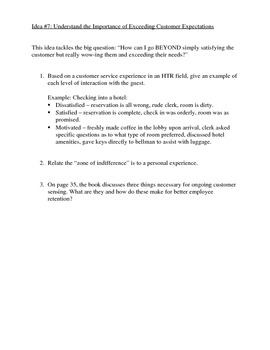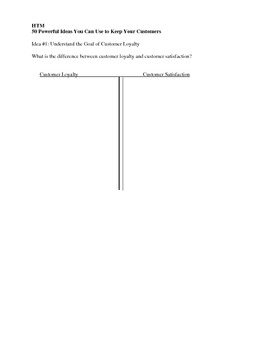50 Most Powerful Ideas in Customer Service writing prompts
JWestbrook
130 Followers
Grade Levels
9th - 12th
Resource Type
Standards
CCSSRST.9-10.1
CCSSRST.9-10.2
CCSSRST.9-10.4
CCSSRST.9-10.5
CCSSRST.9-10.6
Formats Included
- Word Document File
Pages
25 pages
JWestbrook
130 Followers
Description
Paul R. Timm's "50 Most Powerful Ideas You Can Use to Keep Your Customers" is a small book with powerful strategies to increase customer service.
This is a great option for students interested in hospitality/customer service or as a way for students to learn transferable skills and reading non-fiction text. While there are 50 ideas, I have only been able to get through the first 25 in my classes. The other half also build off of the first 25's basic ideas so at this point, this ONLY INCLUDES 25 of the 50 ideas. In time, I will add and finally finish the other half.
I like to use this as a warm up or as a weekly ongoing discussion about customer service as seen through the customer's eyes, the employees, and the manager or owner of the business.
Important: Although it uses a book and it can be expensive for a school to buy a class set, this is also a good chance to read this aloud to your students as practice for the CCSS standardized test that includes an auditory section!
This is a great option for students interested in hospitality/customer service or as a way for students to learn transferable skills and reading non-fiction text. While there are 50 ideas, I have only been able to get through the first 25 in my classes. The other half also build off of the first 25's basic ideas so at this point, this ONLY INCLUDES 25 of the 50 ideas. In time, I will add and finally finish the other half.
I like to use this as a warm up or as a weekly ongoing discussion about customer service as seen through the customer's eyes, the employees, and the manager or owner of the business.
Important: Although it uses a book and it can be expensive for a school to buy a class set, this is also a good chance to read this aloud to your students as practice for the CCSS standardized test that includes an auditory section!
Total Pages
25 pages
Answer Key
N/A
Teaching Duration
N/A
Report this resource to TPT
Reported resources will be reviewed by our team. Report this resource to let us know if this resource violates TPT’s content guidelines.
Standards
to see state-specific standards (only available in the US).
CCSSRST.9-10.1
Cite specific textual evidence to support analysis of science and technical texts, attending to the precise details of explanations or descriptions.
CCSSRST.9-10.2
Determine the central ideas or conclusions of a text; trace the text’s explanation or depiction of a complex process, phenomenon, or concept; provide an accurate summary of the text.
CCSSRST.9-10.4
Determine the meaning of symbols, key terms, and other domain-specific words and phrases as they are used in a specific scientific or technical context relevant to grades 9–10 texts and topics.
CCSSRST.9-10.5
Analyze the structure of the relationships among concepts in a text, including relationships among key terms (e.g., force, friction, reaction force, energy).
CCSSRST.9-10.6
Analyze the author’s purpose in providing an explanation, describing a procedure, or discussing an experiment in a text, defining the question the author seeks to address.




